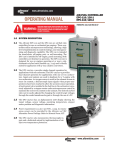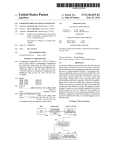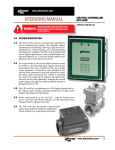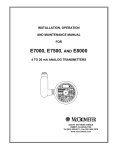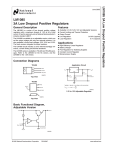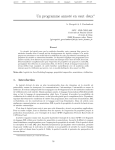Download Emergency Lighting Transfer System User Manual 1997
Transcript
ELTS Normal Load Emergency Emergency Lighting Transfer System User Manual 2 Electronic Theatre Controls, Inc. Emergency Lighting Transfer System User Manual Contents Introduction................................................................................................... 5 How to use this manual ........................................................................... 5 Codes and standards................................................................................ 5 System Diagram....................................................................................... 6 Installation and setup chapters Installation..................................................................................................... 7 Unpack and Inspect.................................................................................. 7 ELTS Models............................................................................................ 8 Mounting the ELTS cabinet...................................................................... 9 Installing Remote stations (optional) ...................................................... 11 Connecting power and control wiring to the ELTS cabinet ................... 12 Transfer switch, Normal power and lighting load connections .............. 13 Control and Sensing wire connections................................................... 15 Testing ......................................................................................................... 18 Before you power up for the first time .................................................. 18 Turn on system ...................................................................................... 18 Functional checkout ............................................................................... 19 Settings ....................................................................................................... 21 ELTS timing settings .............................................................................. 21 ELTS voltage and frequency settings..................................................... 24 Use and service chapters Operation..................................................................................................... 25 Automatic operation............................................................................... 25 Switching power sources manually ....................................................... 26 Service ......................................................................................................... 27 Preventive maintenance......................................................................... 27 Troubleshooting ......................................................................................... 28 Emergency or Normal Power Stable LED does not turn on properly..... 28 The ELTS will not switch between Normal and Emergency.................. 28 Remote stations cannot switch the ELTS.............................................. 29 Appendices Appendix A: ELTS specifications............................................................... 30 Appendix B: Wire connection schematics and diagrams ....................... 31 Appendix C: Transfer switch control system schematics....................... 33 Appendix D: Transfer switch load switching schematic......................... 34 Appendix E: Test and Maintenance Log ................................................... 35 Emergency Lighting Transfer System User Manual 3 4 Electronic Theatre Controls, Inc. Emergency Lighting Transfer System Introduction Welcome to ETC’s Emergency Lighting Transfer System (ELTS) User Manual. This manual shows you how to install and use your ELTS system. See ELTS Models on page 8 for a breakdown of ELTS models and configurations. How to use this manual This manual is divided into three sections: ▼ Installation on page 7 tells you how to install and test your system ▼ Operation on page 25 tells you how to use and service your system ▼ The Appendix B: Wire connection schematics and diagrams on page 31 contains additional information you may need Warnings and notice conventions These symbols alert you to danger or important information: Warning! Warns you when electricity may cause injury Warning! Warns you when there is a possibility of other types of injury Notice: Alerts you to important information relating to equipment performance or reliability Contacting ETC For questions about ELTS system delivery or general information, contact ETC Customer Service at 800/688-4116. Codes and standards ELTS systems meet the following regulatory standards for emergency lighting transfer devices: Emergency Lighting Transfer System User Manual ▼ ANSI/UL 1008 – Listed, Automatic Transfer Switches ▼ ANSI/NFPA 110 – Emergency and Standby Power Systems ▼ ANSI/NFPA 70 – National Electric Code Article 701 – Legally Required Standby Systems Article 700 – Emergency Systems Article 540 –11(c) – Motion Picture Houses Article 520 – 7 – Theatres and Similar Locations Article 518 – 3(c) – Places of Assembly ▼ City of New York, Advisory board, Electrical Department ▼ OSHA ▼ Department of Defense 5 System Diagram Emergency generator Main power L1 L2 L3 N Normal loads are connected directly to the dimming system. If main power fails, normal loads are dark. L1 L2 L3 N Normal loads Channels 1–6 Normal loads Generator Start L1, L2 and L3 sensing wires Dimmer rack Normal/Emergency loads are routed through the ELTS. Normal load power comes from the dimming system. If the ELTS detects a loss of dimmer normal power, it switches the normal/emergency loads from dimmer normal power to the emergency power source. Normal power Channels 7–12 (into ELTS) Normal/Emergency loads Channels 7–12 (from ELTS) Fire alarm activation Aux activation ELTS cabinet Normal/Emergency loads Up to ten Remote stations can be connected to the ELTS Figure 1: Diagram of a typical ELTS system 6 Electronic Theatre Controls, Inc. Installation Unpack and Inspect Before you begin installation, check your shipment so you know it arrived complete and undamaged. 1. Check the shipping container for obvious physical damage: ▼ Torn or opened containers ▼ Water stains or wetness ▼ Crushed or punctured boxes ▼ Other shipping-related damage 2. If you find damage, document it to help with a claim against your shipper. 3. Unpack your order and check the contents against the Bill of Materials to be sure your order is complete. 4. Open the ELTS cabinet door and check for loose connections or broken components caused by shipping vibration. 5. If you discover a problem with your order, call ETC Customer Service at 800/688-4116. ELTS 850, 1820, 2420 GROUND DUE TO SHIPPING, MFG. IS NOT RESPONSIBLE FOR LOOSE CONNECTIONS, TIGHTEN ALL CONNECTIONS BEFORE ENERGIZING. LUG Control panel ASCO PS Emergency ground lug POWER SUPPLY ASCO GROUP 9 CONTROL PANEL 6 7 8 9 N 5 C 4 N 3 C 2 B ELTS 450, 620, 1220 1 A 10 EPDB A B GROUND DUE TO SHIPPING, MFG. IS NOT RESPONSIBLE FOR LOOSE CONNECTIONS, TIGHTEN ALL CONNECTIONS BEFORE ENERGIZING. LUG ASCO PS POWER SUPPLY ASCO GROUP 9 CONTROL PANEL A Emergency ground lug C N 7 8 9 10 B 6 A SR3B 5 SR3B EPDB 4 SR3B N 3 SR3B C 2 ELTS power supply B 1 Emergency Line and Neutral lugs NL6 EN6 LN6 NN5 EL6 LL6 EN4 NN4 EL4 NL4 NN3 LN4 LL4 T1 T2 3 T3 T4 5 T5 6 T6 7 T7 8 T8 9 T9 10 T10 11 T11 12 T12 1 R1 2 R2 3 R3 4 R4 5 R5 ELTS power supply SR3B SR3B SR3B SR3B Isolation relays 6 NL3 EN3 LN3 EL3 LL3 1 2 4 NL5 EN5 LN5 EL5 NN5 NL5 NN4 NL4 LL5 NN6 NL6 EN6 LN6 Emergency Line and Neutral lugs NN2 R5 EN2 R4 LN2 R3 5 EL3 R2 3 LL3 2 4 EN2 R1 LN2 1 NN3 T12 NL3 T11 NN2 T10 11 12 LN3 10 EL6 T9 12 POLE TRANSFER SWITCH LL6 T8 9 TS2 12 POLE TRANSFER SWITCH EN5 8 TS1 LN5 T7 EL5 T6 LL5 T5 EN4 T4 6 7 LN4 T3 5 EL4 T2 3 LL4 2 4 EN3 T1 NN6 Isolation relays 1 1 F1 2 F2 TS1 TS2 12 POLE TRANSFER SWITCH 12 POLE TRANSFER SWITCH NN6 NL2 NN1 EN6 EL2 EN1 LN6 LL2 LN1 NN6 NL2 NN1 EN6 EL2 EN1 A1 A2 1 NL6 EL6 LL6 NL6 EL6 NL1 EL1 LL1 LL6 3 NL1 F2 EL1 F1 LL1 1 2 1 2 LN6 LL2 LN1 3 6 G1 NN5 EN5 NL5 EL5 LL5 NL5 NN4 NL4 LN4 EN4 EL4 LL4 NN4 EN4 NN3 EN3 LN3 NN3 EN3 NL3 EL3 LL3 NL3 EL3 NN2 EN2 LN2 NN2 LN2 EN2 NL2 EL2 LL2 NL2 EL2 LL2 EA EN1 4 NN1 LN1 EC EL1 5 NL1 12 POLE TRANSFER SWITCH NC LL1 5 NC NN1 12 POLE TRANSFER SWITCH 4 3 NL1 TS4 EN1 TS3 6 LN5 EN5 NN5 LN5 EN5 NN5 NL5 LL5 EL5 NL5 EC EL5 3 TS11 TS29 3 2 TB3 5 1 3 4 2 3 TB1 TB2 2 1 2 1 NN6 NL6 LN6 EN6 EL6 LL6 NN6 EL6 NL6 EA LL6 1 EN6 LN6 6 LL5 Terminal blocks NB 1 2 LN1 2 6 EL1 NA 5 LL1 Terminal blocks G3 LL3 4 6 3 NB LN3 3 G2 4 1 NA 2 2 5 NL4 1 EL4 G1 LL4 LN4 G3 1 1 5 6 3 EL5 LL5 2 2 4 1 LN5 G2 3 3 3 A2 NN5 2 A1 EN5 LN5 3 1 2 3 4 5 6 TS30 7 TS10 8 TS12 NN4 EN4 LN4 NN4 EN4 LN4 6 NL4 NN3 EL4 NL3 LL4 LN3 EN3 EL3 NL3 LL3 NL4 NN3 EL4 EN3 LN3 LL3 NN2 NL2 EN2 NN1 NL1 LN2 EN1 EL2 LN1 LL2 NN2 EN2 EL2 LL2 NL2 EL1 TS12 LL1 TS10 NN1 TS30 8 NL1 TS29 7 EN1 TS11 6 LN1 TB3 5 EL1 TB2 3 LN2 TB1 2 4 LL1 1 EL3 LL4 9 3 3 2 2 1 1 9 Transfer switch assemblies Figure 2: Identifying ELTS components Emergency Lighting Transfer System User Manual 7 ELTS Models Large ELTS cabinet (30" wide x 54" tall x 9" deep) ELTS 850 8 circuits of 50 amps ELTS 1820 18 circuits of 20 amps ELTS 2420 24 circuits of 20 amps Electronic Theatre Controls Inc. MODEL ELTS AUTOMATIC TRANSFER SWITCH FOR EMERGENCY SYSTEMS ISSUE NO. 934 Small ELTS cabinet (30" wide x 36" tall x 9" deep) ELTS 450 4 circuits of 50 amps ELTS 620 6 circuits of 20 amps ELTS 1220 12 circuits of 20 amps Operational Current: 200A Max 3 Phase Operational Voltage: 120/208v (3p+N+ ) Frequency: 50/60Hz. NORMAL POWER Short-circuit current: 10,000 AIC STABLE Electronic Theatre Controls Inc. Middleton, WI Made in USA ® C ® UL1008 Listed EMERGENCY POWER STABLE NORMAL OPERATION EMERGENCY OPERATION GENERATOR START FIRE ALARM TRANSFER SIGNAL EMERGENCY POWER AUTO NORMAL POWER AUXILIARY TRANSFER SIGNAL 1 2 3 4 5 6 7 8 9 10 11 12 13 14 15 16 17 18 19 20 21 22 23 24 Electronic Theatre Controls Inc. MODEL ELTS AUTOMATIC TRANSFER SWITCH FOR EMERGENCY SYSTEMS ISSUE NO. 934 Operational Current: 200A Max 3 Phase Operational Voltage: 120/208v (3p+N+ ) Frequency: 50/60Hz. NORMAL POWER Short-circuit current: 10,000 AIC STABLE Electronic Theatre Controls Inc. Middleton, WI Made in USA ® C ® UL1008 Listed EMERGENCY POWER STABLE NORMAL OPERATION EMERGENCY OPERATION GENERATOR START FIRE ALARM TRANSFER SIGNAL EMERGENCY POWER AUTO NORMAL POWER AUXILIARY TRANSFER SIGNAL 1 2 3 4 5 6 7 8 9 10 11 12 Figure 3: Large and small ELTS cabinets Remote station (part # 1093A2023) NORMAL OPERATION NORMAL POWER EMERGENCY OPERATION AUTO ▼ Provides front panel keyswitch control at remote locations. ▼ Link up to ten stations with parallel wiring. ▼ Normal and Emergency LEDs indicate ELTS status. EMERGENCY POWER Figure 4: Remote station 8 Electronic Theatre Controls, Inc. Mounting the ELTS cabinet Mount the ELTS on a load-bearing wall, in a location where it will not be subject to tampering or vandalism. If possible, install the ELTS where it is most secure from damage by a fire, flood or other incident likely to require its use. Do not install the ELTS inside any other electrical enclosure. Physical requirements for mounting You must mount either size ELTS cabinet with sufficient front clearance (30 inches) to allow the door to open completely. Electronic Theatre Controls Inc. MODEL ELTS AUTOMATIC TRANSFER SWITCH FOR EMERGENCY SYSTEMS ISSUE NO. 934 Operational Current: 200A Max 3 Phase Operational Voltage: 120/208v (3p+N+ ) Frequency: 50/60Hz. NORMAL POWER Short-circuit current: 10,000 AIC STABLE Electronic Theatre Controls Inc. Middleton, WI Made in USA ® C ® UL1008 Listed EMERGENCY POWER STABLE NORMAL OPERATION EMERGENCY OPERATION GENERATOR START FIRE ALARM TRANSFER SIGNAL EMERGENCY POWER AUTO NORMAL POWER AUXILIARY TRANSFER SIGNAL 1 2 3 4 5 6 7 8 9 10 11 12 13 14 15 16 17 18 19 20 21 22 23 24 Electronic Theatre Controls Inc. MODEL ELTS AUTOMATIC TRANSFER SWITCH FOR EMERGENCY SYSTEMS ISSUE NO. 934 55.187" (bolts) Operational Current: 200A Max 3 Phase Operational Voltage: 120/208v (3p+N+ ) 54.000" (cabinet) Frequency: 50/60Hz. NORMAL POWER Short-circuit current: 10,000 AIC STABLE Electronic Theatre Controls Inc. Middleton, WI Made in USA ® C ® UL1008 Listed EMERGENCY POWER STABLE NORMAL OPERATION EMERGENCY OPERATION GENERATOR START FIRE ALARM TRANSFER SIGNAL EMERGENCY POWER AUTO NORMAL POWER AUXILIARY TRANSFER SIGNAL 1 2 3 4 5 6 7 8 9 10 11 12 36.000" (cabinet) 37.187" (bolts) 24.250" (bolts) 30.000" (cabinet) 9.375" 24.250" (bolts) 30.000" (cabinet) 9.375" Small cabinet Large cabinet Figure 5: ELTS cabinet mounting dimensions Notice: Emergency Lighting Transfer System User Manual When planning your installation, make sure to leave space around the cabinet for entry and exit wire conduit. Emergency line and neutral conduit may require extra space due to increased bend radius requirements for larger cables. 9 Planning wire entry into the ELTS cabinet The Emergency power connections must enter the cabinet from the top or side of the cabinet within six inches of the top left corner. Control, Normal power sensing and options wires connect most easily if they enter above the Remote station terminal or just below the Emergency sensing terminal on the left side of the cabinet. Note: Do not run the control, normal power sensing and options wiring in the same conduit as Emergency phase or load power wiring. Load wires in from the dimmer rack and out to the lighting loads connect most easily if they enter through the bottom of the cabinet either between or beside the transfer switch assemblies. Note: Except for the emergency power supply wires, which must enter near the top left corner of the cabinet, recommended conduit entry locations may be changed based on the requirements of your installation. Control panel GROUND DUE TO SHIPPING, MFG. IS NOT RESPONSIBLE FOR LOOSE CONNECTIONS, TIGHTEN ALL CONNECTIONS BEFORE ENERGIZING. LUG ASCO PS POWER SUPPLY ASCO GROUP 9 CONTROL PANEL 6 7 8 9 N 5 C 4 N 3 C 2 B 1 A 10 EPDB Emergency power conduit entry area A B Isolation relays Emergency power lugs ELTS power supply SR3B SR3B SR3B SR3B Transfer switch assembly NL6 EN6 LN6 NN5 EL6 LL6 NL5 EN5 LN5 NN4 EL5 LL5 NL4 EN4 LN4 NN3 EL4 LL4 NL3 EN3 LN3 NN2 EL3 LL3 NL2 EN2 LN2 EL2 LL2 NN6 NL6 NN5 NL5 NN4 EL4 LL4 EN3 LL3 EL3 LN3 R5 EN2 R4 LN2 R3 EL2 R2 5 LL2 R1 3 NN1 NL1 EN1 LN1 EL1 F2 LL1 F1 2 NN1 1 NL1 LN1 EN1 6 EL1 Fire alarm transfer 1 2 4 LL1 Remote stations NL4 T12 NN3 T11 NL3 T10 NN2 T9 NL2 T8 9 11 12 EN6 8 10 12 POLE TRANSFER SWITCH LN6 T7 TS2 12 POLE TRANSFER SWITCH EL6 7 TS1 LL6 T6 EN5 T5 LN5 T4 EL5 T3 6 LL5 T2 5 EN4 T1 3 LN4 Recommended control conduit location 1 2 4 NN6 Factory wired terminal 3 2 A1 A2 2 1 2 1 1 Auxiliary transfer 3 3 3 1 Generator start G1 2 3 G2 4 5 G3 6 1 NA 2 Normal sensing 3 NB TS3 TS4 12 POLE TRANSFER SWITCH 12 POLE TRANSFER SWITCH 4 5 NC NN6 Transfer switch manual operation handle NL6 LN6 EN6 EL6 LL6 NN6 EL6 NL6 EA LL6 1 NN5 EN5 LN5 NN5 EC EN5 3 LN5 2 NL5 EL5 LL5 LL5 5 NL5 4 EL5 Emergency sensing EN6 LN6 6 NN4 NL4 NN3 LN4 EN4 EL4 LL4 NL3 LL3 EL3 NL3 NN2 LN2 EN2 NN2 EN3 NN3 EL3 EN2 LN3 NN4 NL4 EN4 EL4 LL4 LL3 LN2 LN3 NL2 NL1 NN1 EL2 LL2 EN1 EL2 NL2 LN1 TS12 EL1 8 LL1 TS10 NN1 TS30 NL1 TS29 7 EN1 TS11 6 LN1 TB2 TB3 5 LL2 TB1 3 EL1 1 2 4 LL1 Recommended control conduit location EN3 LN4 6 3 2 1 1 Factory wired terminal 2 3 9 Recommended load input and output conduit locations Figure 6: ELTS components 10 Electronic Theatre Controls, Inc. Mounting the cabinet After determining where you want to install the cabinet, follow these instructions. 1. Install two 3/8" bolts 24.25 inches apart for the lower two support slots (the installer must supply the mounting hardware). 2. Use the mounting dimensions from Figure 5 : ELTS cabinet mounting dimensions on page 9 to drill the holes for the upper two 3/8" bolts. 3. Place the ELTS cabinet on the wall supported by the two lower bolts. Notice: ELTS cabinets are very heavy. Make sure you have adequate equipment (or help) to lift the cabinet into place and support it while you secure the top two bolts. 4. Secure the ELTS to the wall with the two upper 3/8" bolts. Installing Remote stations (optional) 1. Install a standard two gang backbox (4" x 4" x 3.5") and run wire conduit from it to the ELTS cabinet. 2. Pull five conductor, Class 2 (12 Vdc) wiring through from the backbox to the cabinet. 3. Connect the wires to the terminal strip on the back of the remote station. Note which terminal each wire connects to. 4. Install the Remote station onto the backbox with four 6 - 32 x 1/2" oval head machine screws (provided). 5. To install multiple Remote stations, repeat steps 1 – 4, wiring in parallel between Remote station terminal blocks. Refer to Connecting Remote stations to the ELTS on page 16 for instructions for connecting Remote station wiring inside the ELTS cabinet. Emergency Lighting Transfer System User Manual 11 Connecting power and control wiring to the ELTS cabinet Warning! To prevent death or injury due to electrical shock, Normal and Emergency power to the ELTS must be turned off any time you are connecting or servicing any ELTS. Connecting Emergency power The Emergency power lugs are in the upper left of the ELTS cabinet. The ELTS is available in one or three phase power configurations. 1. Cut a hole within six inches of the top left corner of the ELTS cabinet 2. Install conduit and pull the Emergency power cables into the cabinet. Note: Top conduit connections are recommended to reduce the cable bending necessary to connect to the lugs. Table 1: Emergency power lug wire sizes and connection torques Connection type Wire size Torque Phase and Neutral lugs (3 phase) 6 AWG to 2/0 275 in/lbs Phase and Neutral lugs (single phase) 6 AWG to 250 MCM 275 in/lbs Ground lug (both phase types) 50 in/lbs 14 AWG to 2/0 Three phase (4 wire) connections 1. Connect each phase power cable to the correct lug. See Figure 7, below, to identify the lugs. 2. Connect the Neutral cable to the Neutral lug. 3. Connect the Ground cable to the Ground lug. GROUND DUE TO SHIPPING, MFG. IS NOT RESPONSIBLE FOR LOOSE CONNECTIONS, TIGHTEN ALL CONNECTIONS BEFORE ENERGIZING. LUG Phase C lug (Three phase ELTS only) Ground lug Phase A lug A B C N A B C N Phase B lug Neutral lug Figure 7: Connecting Emergency power to the ELTS Single phase connection (3 wire) 1. Connect one phase cable to the Phase A lug and one to the Phase B lug. See Figure 7, above, to identify lugs. 2. Connect the Neutral cable to the Neutral lug. 3. Connect the Ground cable to the Ground lug 12 Electronic Theatre Controls, Inc. Transfer switch, Normal power and lighting load connections Each transfer switch can have up to six 20 amp circuits or two 50 amp circuits connected to it. You need to connect Line and Neutral inputs from the dimmer rack and outputs to the emergency lighting loads. The Line and Neutral input from Emergency power are delivered prewired. Table 2Switch assembly wire sizes and connection torques Circuits Circuits 1–6 7 – 12 Circuits 13 – 18 Wire size Torque Wire size Torque 14 – 10 AWG 35 in/lbs 8 AWG 40 in/lbs 6 – 4 AWG 45 in/lbs 3 AWG to 2/0 50 in/lbs 20 amp dimmer rack Load and Neutral wire input connections Circuits 19 – 24 1. Attach the conduit for the wires from the dimmer rack to the bottom of the ELTS cabinet (recommended.) 2. Connect a Neutral wire for each dimmer circuit to terminals NN1 through NN6 on the right side of the transfer switch assembly. See Figure 8, left, to match switch assemblies to loads. Figure 8: 20 amp Transfer switch circuit assignments 3. Connect a Line wire for each dimmer circuit to terminals NL1 through NL6 on the right side of the transfer switch assembly. 4. Repeat steps 2 and 3 for the other transfer switch assemblies. NN6 NL6 EN6 NN5 NL5 NN4 NL4 EN3 NN3 NL3 NN2 Neutral wire from dimmer NL2 NN1 NL1 EL2 NN2 LL6 EL6 EN5 LN5 LL5 EL5 EN4 LN4 LN3 EL3 LL2 EN1 Line wire from dimmer Prewired Emergency Line and Neutral input terminals NL1 1 2 Prewired Emergency feeds NN1 3 LL1 LN1 LN2 LL3 LL4 EN6 EL6 EN5 EL5 EN2 LN6 LL6 LN5 LL5 EL4 LN6 12 POLE TRANSFER SWITCH EL1 Lighting load Line output wire Input connections for Line and Neutral wires from the dimmer rack (Normal power) TS1 NL2 Lighting load Line and Neutral terminals Lighting load Neutral output wire Figure 9: 20 amp Transfer switch connections for Line and Neutral wires 20 amp lighting load Line and Neutral output connections 1. Attach the conduit for the wires to the lighting loads through the bottom of the ELTS cabinet (recommended). 2. Connect a Neutral wire for each lighting load to terminals LN1 through LN6 on the left side of the transfer switch assembly. See Figure 8, above, to match switch assemblies to loads. 3. Connect a Line wire for each lighting load to terminals LL1 through LL6 on the left side of the transfer switch assembly 4. Repeat steps 2 and 3 for the other transfer switch assemblies. Emergency Lighting Transfer System User Manual 13 50 amp dimmer rack Load and Neutral wire input connections 1. Attach the conduit for the wires from the dimmer rack to the bottom of the ELTS cabinet (recommended.) 2. Connect a Neutral wire for each dimmer circuit to terminals NN1 and NN2 on the right side of the transfer switch assembly. See Figure 10, left, to match switch assemblies to loads. Circuits Circuits 1&2 3&4 3. Connect a Line wire for each dimmer circuit to terminals NL1 and NL2 on the right side of the transfer switch assembly. 4. Repeat steps 2 and 3 for the other transfer switch assemblies. 50 amp lighting load Line and Neutral output connections Circuits 5&6 Circuits 7&8 Figure 10: 50 amp transfer switch circuit assignments 1. Attach the conduit for the wires to the lighting loads through the bottom of the ELTS cabinet (recommended.) 2. Connect a Neutral wire for each lighting load to terminals LN1 and LN2 on the left side of the transfer switch assembly. See Figure 10, to match switch assemblies to loads. 3. Connect a Line wire for each lighting load to terminals LL1 and LL2 on the left side of the transfer switch assembly 4. Repeat steps 2 and 3 for the other transfer switch assemblies. Lighting load Line and Neutral terminals Input connections for Line and Neutral wires from the dimmer rack (Normal power) TS1 Lighting load Neutral output wire Neutral wire from dimmer NN2 NL2 EN2 EN1 NN1 EL1 NL1 3 LN1 LL1 LL2 Lighting load Line output wire EL2 LN2 4 POLE TRANSFER SWITCH 1 2 Prewired Emergency feeds Line wire from dimmer Prewired Emergency Line and Neutral input terminals Figure 11: 50 amp Transfer switch connections for Line and Neutral wires 14 Electronic Theatre Controls, Inc. Control and Sensing wire connections Door control and indicator connections (prewired) 1 T1 2 T2 3 T3 4 T4 5 T5 6 T6 7 T7 8 T8 9 T9 10 T10 11 T11 12 T12 Control and power sensing wires connect to terminal blocks on the left side of the ELTS cabinet. Terminals can accept from 8 to 22 AWG wires. Torque terminal screws to 18 in/lbs. 1. Install control and sensing wire conduit on the left side of the ELTS cabinet above the remote station connection terminals or below the Emergency power sensing terminals (recommended conduit location). 2. Pull the wires into the cabinet. Connecting the Normal power sensing wires Remote station connections 1 R1 2 R2 3 R3 4 R4 5 R5 6 Fire alarm signal transfer 1 F1 2 F2 3 Auxiliary signal transfer 1 A1 2 A2 3 1 Engine/ generator start G1 2 3 G2 4 5 Normal power sensing Emergency power sensing (prewired) EA 2 3 EC 4 5 Connect phase A to terminal 1 (across from wire NA) ▼ Connect phase B to terminal 3 (across from wire NB) ▼ Connect phase C to terminal 5 (across from wire NC) Note: On single phase (three wire) systems, terminal 5 will not be used. Connecting the Emergency power sensing wires Emergency power sensing wires on ELTS systems with front panel circuit breaker or fuse panels are wired from the Emergency power lugs to the correct terminals on the Emergency power terminal block at the factory. 6 Transfer switch connections (prewired) ▼ NC 6 1 3. Pull the wires from the circuit breakers through wire conduit to the Normal power sensing terminal block in the ELTS cabinet. NB 4 5 2. Connect each sensing wire to a 15 amp circuit breaker close to the dimmer rack. Circuit breakers CANNOT be inside the ELTS cabinet. 4. Connect the sensing wires to the Normal power sensing terminal block: NA 2 3 Note: Power sensing wires must be 12 AWG or larger. 1. Connect a sensing wire to each phase lug of the dimmer rack connected to the ELTS. Mark each wire to identify its phase at the ELTS rack. G3 6 1 Normal power sensing wires connect to the phase lugs of the dimmer rack connected to the ELTS. They attach to the Normal power sensing terminal block. Each sensing wire must connect to the ELTS through a 15 amp circuit breaker located outside the ELTS cabinet. 1 TB1 2 TB2 3 TB3 4 TS11 5 TS29 6 TS30 7 TS10 8 TS12 9 Figure 12: Control and Sensing wire terminal connections Sensing wires on systems without front panel circuit breakers must be wired into the ELTS cabinet. Note: Emergency power sensing wires must be 12 AWG or larger. 1. Connect a sensing wire to phase A and C (A and B on single phase systems) of the Emergency power supply. Mark each wire to identify its phase at the ELTS rack. 2. Pull the wires through the conduit to the Emergency power sensing terminal block in the ELTS cabinet. 3. Connect the sensing wires to the Emergency sensing terminal block: ▼ Connect phase A to terminal 1 (across from wire NA) ▼ Connect phase C to terminal 5 (across from wire NC) Note: On single phase (three wire) systems, connect phase B to terminal 5. Emergency Lighting Transfer System User Manual 15 Connecting the Engine/generator starting wires Closed start signal 1 G1 1. Connect two wires to the terminals of your engine/generator starting circuit. 2 Always connected 3 G2 4 Open start signal 5 The ELTS system can provide both normally open and normally closed starting circuits for engine generator activation. G3 6 Note: Consult your generator installation manual for start signal wiring information. 2. Pull the wires through the conduit to the engine/generator start terminal block. 3. Connect one of the starting wires to terminal 3 (across from wire G2). Figure 13: Connections for Engine/generator starting wires 4. Connect the other starting wire to terminal 1 or 5: ▼ For a closed start signal, connect the wires to terminal 1 (across from wire G1) ▼ For an open start signal, connect the wires to terminal 5 (across from wire G3) Connecting Remote stations to the ELTS You can connect up to 10 Remote stations to the ELTS with parallel wiring. For Remote station installation instructions see page 11. Remote 1 1 R1 Remote 2 2 R2 1. Pull the Remote station wires the Remote station terminal. Remote 3 3 R3 2. Connect the Remote wire 1 (Common) to terminal 1 (across from wire R1). Remote 4 4 R4 Remote 5 5 R5 3. Connect the Remote wire 2 (Emergency Select) to terminal 4 (across from wire R2). 6 Figure 14: Connections for Remote stations 4. Connect the Remote wire 3 (Normal Select) to terminal 5 (across from wire R3). 5. Connect the Remote wire 4 (Normal indicator LED) to terminal 2 (across from wire R4). 6. Connect the Remote wire 5 (Emergency indicator LED) to terminal 3 (across from wire R5). 16 Electronic Theatre Controls, Inc. Connecting fire alarm activation You can connect your ELTS to your fire alarm system so it switches to Emergency when the alarm is triggered. Your fire alarm system must be able to provide an open signal when it activates. Remove Fire alarm shorting wire and install Fire alarm circuit wires in terminals 1 and 2 1. Connect two wires to the terminals of your fire alarm activation circuit. 2. Pull the wires through the conduit to the fire alarm terminal block. 1 F1 3. Remove the shorting wire between terminal 1 and terminal 2. 2 F2 4. Connect one wire to terminal 1 (across from wire F1). 5. Connect the other wire to terminal 2 (across from wire F2). 3 Remove Aux. shorting wire and install Aux. circuit wires in terminals 1 and 2 1 A1 2 A2 3 Figure 15: Connecting fire alarm and auxiliary circuit wires Note: If you do not use the fire alarm activation feature, leave the shorting wire in place or the ELTS will not operate properly. Connecting auxiliary activation You can connect your ELTS to an auxiliary circuit so it switches to Emergency when the circuit is triggered. Your auxiliary circuit must provide an open signal when it activates. 1. Connect two wires to the terminals of your auxiliary circuit. 2. Pull the wires through the conduit to the auxiliary terminal block. 3. Remove the shorting wire between terminal 1 and terminal 2. 4. Connect one wire to terminal 1 (across from wire A1). 5. Connect the other wire to terminal 2 (across from wire A2). Note: If you do not use the auxiliary activation feature, leave the shorting wire in place or the ELTS will not operate properly. Emergency Lighting Transfer System User Manual 17 Testing Before you power up for the first time Checking transfer switch operation manually By checking transfer switch manual operation before you apply power, you reduce the possibility of failure caused by mechanically frozen, damaged or obstructed switches. Each switch should rotate without catching or binding. Warning! Normal and Emergency power should be off when you open the ELTS cabinet for to check switch operation. Opening the cabinet with power applied exposes you to death or injury from electrical shock. 1. Open the ELTS cabinet. Warning! Rotating the transfer switch assemblies manually with Normal or Emergency power applied may result in the assemblies switching automatically, causing severe hand injuries. 2. Turn the manual operation handle 90° clockwise. E (Emergency) should be visible on the assembly about 1.5 inches above the handle. 3. Rotate the handle 180° counter-clockwise. N (normal) should be visible. Note: If you have difficulty operating the switch, check for installation debris that may be blocking switch operation. 4. Repeat steps 2 and 3 with the remaining transfer switch assemblies. Turn on system Voltage checkout 1. Apply power to the ELTS and connected dimmer rack at the main circuit breaker. The green Normal LED lights. 2. Apply emergency power. The red Emergency light turns on. Warning! ELTS voltage tests should only be performed by qualified personnel using EXTREME caution. Opening the cabinet with power applied exposes you to death or injury from electrical shock. 3. Open the ELTS cabinet. 4. Use a digital voltmeter (DVM) to test the feed voltage at the Normal power sensing terminal block (Figure 12 on page 15 for location). Phase A is on terminal 1, phase B on terminal 3 and phase C on terminal 5. Voltage must be within ± 10 percent of the rated voltage for the ELTS. 5. Use the DVM to test the feed voltage at the Emergency power lugs. Phase lugs are labeled either A, B or C. Voltage values must be within ± 10 percent of the rated voltage for the ELTS. 6. Close the ELTS cabinet. 18 Electronic Theatre Controls, Inc. Functional checkout After verifying the Normal and Emergency voltages, check the ELTS system functions. Lit if Normal power is acceptable Lights when Emergency power is used Lit if Emergency power is acceptable Electronic Theatre Controls Inc. MODEL ELTS AUTOMATIC TRANSFER SWITCH FOR EMERGENCY SYSTEMS Lights when Normal power is used ISSUE NO. 934 Operational Current: 200A Max 3 Phase Operational Voltage: 120/208v (3p+N+ ) Frequency: 50/60Hz. Short-circuit current: 10,000 AIC NORMAL POWER STABLE Electronic Theatre Controls Inc. Middleton, WI Made in USA ® © ® UL1008 Listed NORMAL OPERATION EMERGENCY OPERATION EMERGENCY POWER STABLE GENERATOR START Keyswitch selects ELTS preference between Normal and Emergency NORMAL POWER AUTO EMERGENCY POWER FIRE ALARM TRANSFER SIGNAL AUXILIARY TRANSFER SIGNAL Lights when ELTS sends a Generator start signal Lights when ELTS receives a fire alarm activation Lights when ELTS receives a auxiliary activation Figure 16: Local control operation and LED indications Switch function 1. Insert the key into the keyswitch on the front panel of the ELTS. 2. Turn the key to EMERGENCY POWER. The red light above EMERGENCY OPERATION turns on and the emergency loads go to full brightness. If Emergency power is provided by an engine/generator, there will be a short delay as the generator turns on and the voltage and frequency stabilize. 3. Release the key. The keyswitch returns to AUTO (center) and the EMERGENCY OPERATION light remains on. 4. Turn the key to the NORMAL POWER position. The green light below NORMAL OPERATION turns on if the system is functioning correctly. 5. Release the key. The keyswitch returns to AUTO and the NORMAL OPERATION light remains on. Remote switch functions After confirming correct function of the keyswitch on the front of the ELTS cabinet, repeat the switch function checkout procedure at EVERY remote station installed on your system. Emergency Lighting Transfer System User Manual 19 Automatic function The automatic function tests the ELTS’s ability to switch back and forth from Normal to Emergency when Normal power is interrupted or restored. 1. Make sure the NORMAL OPERATION LED is lit on the ELTS front panel. 2. Turn off the normal power to the dimmer rack connected to the ELTS. The NORMAL OPERATION and NORMAL POWER STABLE LEDs on the ELTS front panel goes out and the ELTS switches to Emergency power (the EMERGENCY OPERATION and EMERGENCY POWER STABLE LEDs light, and the emergency loads go to full brightness.) If Emergency power is provided by an engine/generator, there will be a short delay before switching as the generator turns on and the voltage and frequency stabilize. 3. Turn the Normal power back on. The ELTS switches back to Normal power after the retransfer delay times out (the default setting is one minute). On the front of the ELTS, the EMERGENCY OPERATION and EMERGENCY POWER STABLE LEDs turn off and the NORMAL OPERATION and NORMAL POWER STABLE LEDs light. If used, the Emergency power engine/generator turns off when the cool down time is complete. Options function ELTS systems can also be activated by fire alarm and auxiliary circuits. Both are operated by a normally closed circuit controlled by the fire alarm or auxiliary relays. When the fire alarm or auxiliary circuit activates, the relay opens, causing the ELTS to switch to Emergency power. To test option relay function, either: ▼ Activate the fire alarm or auxiliary relay. The ELTS should switch to Emergency power and the emergency loads should go to full. ▼ If you do not wish to activate the fire alarm or auxiliary circuit, generate an open circuit at the ELTS connection to the fire alarm or auxiliary circuit by disconnecting one of the two wires to the ELTS cabinet. The ELTS will switch to Emergency power and the emergency loads should go to full. Note: The second method tests the ELTS response to an open circuit, but does not confirm the fire alarm or auxiliary relay’s ability to open the circuit to the ELTS. 20 Electronic Theatre Controls, Inc. Settings ELTS timing settings ELTS timing settings for momentary outage override, transfer to Emergency delay, return to Normal delay, and generator cool down are set at the factory. You can adjust settings for specific applications any time after installation. Caution: Only make changes to ELTS timing settings if you are familiar with the system and know the reason for making the change. Table 3: ELTS timing settings Latch Cover Delay type Default setting Range DIP Switch Adjustment Pot. Momentary Outage override 1 second 0.5 - 6 seconds Transfer to Emergency delay 0 0 - 60 seconds 0 - 8 minutes SW2 up SW2 down P2 Return to Normal delay 30 minutes 0 0.5 - 30 minutes SW1 up SW1 down P1 Generator cool down cycle 5 minutes 0 - 8 seconds 0.5 - 30 minutes SW3 up SW3 down P3 P4 Getting access to the ELTS control panel Figure 17: Removing the control panel cover To make adjustments, you must access the ELTS control panel. 1. Disconnect Normal and Emergency power to the ELTS. Warning! Opening the ELTS cabinet with power on may result in death or injury from electrical shock. 2. Open the ELTS cabinet. 3. Release the two latches on the control panel cover and remove it. See Figure 17, left. Potentiometer P1 SW1, SW2 and SW3 Potentiometer P3 Potentiometer P2 Potentiometer P4 Figure 18: Adjustment potentiometer and DIP switch locations Emergency Lighting Transfer System User Manual 21 Changing the momentary outage override The momentary outage override is the interval the ELTS will tolerate a Normal power voltage fault without switching to Emergency power. It can be set from 0.5 to 6 seconds using adjustment potentiometer P4. 1. Follow the instructions on page 21 to remove the control panel cover. 2. Locate P4 using Figure 18 : Adjustment potentiometer and DIP switch locations on page 21. 3. Turn P4 clockwise to increase the interval or counterclockwise to decrease it. P4 has a 270° adjustment range. Note: Potentiometer adjustments change timing as a fractions of the adjustment range. For example, turning the pot half its range changes the timing value by 50%. You will need to use some trial and error and a timing device to achieve exact values. Clockwise to increase Counterclockwise to decrease Figure 19: Changing adjustment potentiometer settings Changing the Transfer to Emergency delay DIP switch in Up position SW 1 2 •1 3 •2 • •3 • 1. Follow the instructions on page 21 to remove the control panel cover. •4 • • DIP switch in Down position Figure 20: Setting DIP switches 22 The Transfer to Emergency delay sets the time the ELTS waits before switching to Emergency after the Emergency power voltage and frequency stabilize. You can set the delay in two time ranges, from zero to 60 seconds or zero to 8 minutes, using DIP switch SW2 and adjustment potentiometer P2. 2. Locate SW2 using Figure 18 : Adjustment potentiometer and DIP switch locations on page 21. 3. To select the zero to 60 second adjustment range put SW2 up. To select the zero to 8 minute range, put SW2 down. 4. Locate P2 using Figure 18 : Adjustment potentiometer and DIP switch locations on page 21. 5. After setting the range, turn P2 clockwise to increase the interval or counterclockwise to decrease it. P2 has a 270° adjustment range. Electronic Theatre Controls, Inc. Changing the Return to Normal delay The Return to Normal delay sets the time the ELTS waits before switching from Emergency to Normal after Normal power is restored. The delay can be turned off, or set from 0.5 to 30 minutes using DIP switch SW1 and adjustment potentiometer P1. Note:To disable the delay on a one-time basis (to quickly restart an interrupted performance or for testing purposes) switch the ELTS back to Normal with the front panel Local switch or a Remote keyswitch station. 1. Follow the instructions on page 21 to remove the control panel cover. 2. Locate SW1 using Figure 18 : Adjustment potentiometer and DIP switch locations on page 21. 3. To turn off the delay put SW1 up. To set the range from 0.5 to 30 minutes, put SW1 down. 4. If SW1 is down, locate P2 using Figure 18 : Adjustment potentiometer and DIP switch locations on page 21. 5. Turn P2 clockwise to increase the interval or counterclockwise to decrease it. P2 has a 270° adjustment range. Changing the Generator cool down interval The Generator cool down interval sets the time the ELTS waits before shutting off the Emergency power generator after switching back to Normal power. It can be set from zero to 8 seconds or 0.5 to 30 minutes using DIP switch SW3 and adjustment potentiometer P3. Caution: Consult your generator user manual for proper cool down times before changing the Generator cool down interval. 1. Follow the instructions on page 21 to remove the control panel cover. 2. Locate SW3 using Figure 18 : Adjustment potentiometer and DIP switch locations on page 21. 3. To make the adjustment range zero to 8 seconds put SW3 up. To make the range 0.5 to 30 minutes, put SW3 down. 4. Locate P3 using Figure 18 : Adjustment potentiometer and DIP switch locations on page 21. 5. After setting the range, turn P3 clockwise to increase the interval or counterclockwise to decrease it. P3 has a 270° adjustment range. Emergency Lighting Transfer System User Manual 23 ELTS voltage and frequency settings Voltage and frequency settings are set at the factory and should only be adjusted by an authorized ETC representative. Caution: Indiscriminate changes to voltage and frequency sensing settings may affect normal operation of the ELTS and result in switching function failure. Table 4: 120 volt ELTS voltage and frequency settings Description Factory setting Adjustment range Normal source voltage pickup 108 volts 102 – 120 volts Normal source voltage dropout 102 volts 81 – 106 volts Emergency source voltage pickup 108 volts 102 – 120 volts Emergency source voltage dropout 92 volts No adjustment: 15% below pickup setting Emergency source frequency pickup 57 hertz 57 – 60 hertz Emergency source frequency dropout 50 hertz No adjustment: 12% below pickup setting Table 5: 277 volt ELTS voltage and frequency settings Description Factory setting Adjustment range Normal source voltage pickup 249 volts 235 - 277 volts Normal source voltage dropout 235 volts 187 - 244 volts Emergency source voltage pickup 249 volts 235 – 277 volts Emergency source voltage dropout 212 volts No adjustment: 15% below pickup setting Emergency source frequency pickup 57 hertz 57 – 60 hertz Emergency source frequency dropout 50 hertz 24 No adjustment: 12% below pickup setting Electronic Theatre Controls, Inc. Operation Automatic operation During automatic operation the ELTS system switches back and forth from Normal to Emergency when either power supply is interrupted or restored. Lit if Normal power is acceptable Lights when Emergency power is used Lit if Emergency power is acceptable Electronic Theatre Controls Inc. MODEL ELTS AUTOMATIC TRANSFER SWITCH FOR EMERGENCY SYSTEMS ISSUE NO. 934 Lights when Normal power is used Operational Current: 200A Max 3 Phase Operational Voltage: 120/208v (3p+N+ ) Frequency: 50/60Hz. Short-circuit current: 10,000 AIC NORMAL POWER STABLE Electronic Theatre Controls Inc. Middleton, WI Made in USA ® © ® UL1008 Listed NORMAL OPERATION EMERGENCY POWER STABLE EMERGENCY OPERATION GENERATOR START Keyswitch selects ELTS preference between Normal and Emergency NORMAL POWER AUTO EMERGENCY POWER FIRE ALARM TRANSFER SIGNAL AUXILIARY TRANSFER SIGNAL Lights when ELTS sends a Generator start signal Lights when ELTS receives a fire alarm activation Lights when ELTS receives a auxiliary activation Figure 21: Local control LED indications Selecting the preferred power source: Normal or Emergency Using the local keyswitch on the front of the ELTS cabinet or a Remote keyswitch station installed in your facility, you can select either Normal or Emergency as the preferred power source. 1. Insert the key into the keyswitch and select the desired power source: ▼ To select Normal power, turn the key left. The green NORMAL OPERATION LED lights. ▼ To select Emergency power, turn the key right. The red EMERGENCY OPERATION LED lights and the emergency loads go to full. If Emergency power is provided by an engine/generator, there will be a short switching delay as the generator turns on and voltage and frequency stabilize. 2. Release the key. The keyswitch returns to center and the indicator light you selected remains on. The ELTS uses the selected power source. If the selected source’s voltage or frequency drops below the limit, the ELTS will switch to the other source. 3. When the voltage and frequency of the selected source returns to acceptable levels, the ELTS will switch back to it. Remote Station Remote Keyswitch station operation is identical to the local station. Refer to Selecting the preferred power source: Normal or Emergency for instructions. Fire alarm or Aux signal switching If desired, the ELTS system can be activated by fire alarm or auxiliary circuits. When the ELTS receives the fire alarm or auxiliary circuit activation, it will switch to Emergency power. Note: If you have selected Emergency as the preferred power with either the Local or Remote keyswitch, the ELTS will not switch power sources after receiving a fire alarm or auxiliary activation. Emergency Lighting Transfer System User Manual 25 Switching power sources manually If you need to switch the ELTS from one power source to another when the electronic switching circuits will not function (for example, if you needed to use either Normal or Emergency power, but the voltage or frequency was below the limit) you can set the transfer switch assemblies manually. 1. Disconnect Normal AND Emergency power. Warning! Turn off Normal and Emergency power to the ELTS at the main circuit breaker.Opening the cabinet with power applied exposes you to death or injury from electrical shock. 2. Open the ELTS cabinet. 3. Disconnect the large brown connector on the lower left side of the control panel. Squeeze the release tabs on both sides of the socket together and pull the plug out ASCO GROUP 9 CONTROL PANEL Figure 22: Removing the control panel connector Warning! Operating switch assemblies manually without disconnecting the control panel connector may result in the assemblies switching back automatically, causing severe hand injuries. ▼ To switch from Normal to Emergency power: Turn the manual operation handle on the bottom of each transfer switch assembly 90° clockwise. E (Emergency) should be visible just above the handle. ▼ To switch from Emergency to Normal: Turn the manual operation handle on the bottom of each transfer switch assembly 90° counter-clockwise. N (normal) should be visible just above the handle. 4. Close the cabinet door and restore power to the ELTS. Note: Do not plug the control panel connector back in until you want the ELTS to resume automatic operation. Restoring automatic operation 1. Disconnect Normal AND Emergency power. Warning! Turn off Normal and Emergency power to the ELTS at the main circuit breaker.Opening the cabinet with power applied exposes you to death or injury from electrical shock. 2. Open the ELTS cabinet. 3. Reconnect the large brown connector on the lower left side of the control panel. 4. Close the cabinet door and restore power to the ELTS. 26 Electronic Theatre Controls, Inc. Service Preventive maintenance Regular testing and simple maintenance of your ELTS system will result in long service life and reliable performance. To assist in documenting your test and maintenance schedule, a blank Test and Maintenance Log is included on page 35. We suggest you post a copy near your ELTS cabinet. Warning! Turn off Normal and Emergency power to the ELTS at the main circuit breaker.Opening the cabinet with power applied exposes you to death or injury from electrical shock. Warning! Rotating the transfer switch assemblies manually with Normal or Emergency power applied may result in the assemblies switching automatically, causing severe hand injuries. Monthly testing 1. Manually test the ELTS’s transfer function at the local keyswitch on the front of ELTS cabinet. See Switch function on page 19 for keyswitch instructions and indications. 2. Note the test results in the test and maintenance log. Quarterly testing and maintenance 1. Manually test the ELTS’s transfer function at the local keyswitch on the front of ELTS cabinet. See Switch function on page 19 for keyswitch instructions and indications. 2. Test the ELTS Auto transfer function. See Automatic function on page 20 for automatic transfer instructions and indications. 3. Visually inspect the ELTS cabinet for loose wires or component damage. 4. Note the test results in the test and maintenance log. Annual testing and maintenance 1. Manually test the ELTS’s transfer function at the local keyswitch on the front of ELTS cabinet. See Switch function on page 19 for keyswitch instructions and indications. 2. Test the ELTS Auto transfer function. See Automatic function on page 20 for automatic transfer instructions and indications. 3. Visually inspect the ELTS cabinet for loose wires or component damage. 4. Retighten ELTS phase, neutral and ground lugs using values in Table 1 : Emergency power lug wire sizes and connection torques on page 12. 5. Vacuum the ELTS cabinet to remove dust and debris that may have collected. 6. Note the test results in the test and maintenance log. Emergency Lighting Transfer System User Manual 27 Troubleshooting If you have trouble with an installed ELTS system, you can contact ETC Technical Service at 800/775-4382. Warning! Trouble shooting usually involves opening the ELTS cabinet and metering voltages. Opening the ELTS cabinet with power applied exposes you to death or injury from electrical shock. Use extreme caution during all troubleshooting activities. Emergency or Normal Power Stable LED does not turn on properly During normal operation, either the Normal Power Stable or Emergency Power Stable LED should be lighted. If one or the other does not light, the problem may be with the LED, Normal or Emergency sensing wiring, or Normal or Emergency power. 1. Switch between Normal and Emergency power on the ELTS control panel keyswitch and observe the results. The ELTS should switch between Normal and Emergency power. ▼ The ELTS switches between Normal and Emergency 1. Check for loose LED wire connections or defective LEDs. 2. Make sure the Control Panel connector is properly seated. ▼ The ELTS does not switch between Normal and Emergency. Go to the next ELTS troubleshooting section. The ELTS will not switch between Normal and Emergency If the system will not switch from Emergency power 1. check for tripped Normal power sensing wire circuit breakers. 2. If the circuit breakers are not tripped, meter Normal power using the procedures in Voltage checkout on page 18. If the system will not switch from Normal power 1. Meter Emergency power using the procedures in Voltage checkout on page 18. 2. If no fire alarm or auxiliary circuits are connected to the ELTS, make sure the terminal jumpers are in place. 3. If fire alarm or auxiliary circuits are connected, meter between the wires to be certain the circuit is closed. An open circuit switches the ELTS to Emergency power. If the system does not seem to function in either Normal or Emergency power mode 1. Make sure the control panel connector is properly seated. 2. Check other wire connections for loose terminals or broken wires. 3. Use the procedures in Checking transfer switch operation manually on page 18 to test the switching mechanism for mechanical problems. 28 Electronic Theatre Controls, Inc. Remote stations cannot switch the ELTS 1. Switch between Normal and Emergency power on the ELTS control panel keyswitch and observe the results. If the ELTS does not switch locally Follow the instructions in The ELTS will not switch between Normal and Emergency on page 28. If the ELTS switches locally Try switching the ELTS from other Remote station, if multiple stations have been installed 1. If the other stations function, check the wire terminal connections on the problem station. See Installing Remote stations (optional) on page 11 for station connection requirements. 2. If the other stations do not function, or there is only one Remote station installed. 3. Check the wire connections on the Remote station terminal block. 4. Check the Remote station fuse in the ELTS cabinet Remove this cover on the left side of the Isolation relays to check the Remote station fuse SR3B SR3B SR3B SR3B Figure 23: Locating the Remote station fuse 5. Inspect the wiring between the ELTS cabinet and the stations for defects. See Connecting Remote stations to the ELTS on page 16 for ELTS connection requirements. Some ELTS circuits do not switch when the system changes sources Partial switching of ELTS circuits indicates one or more transfer switch assemblies, or the wiring to them, is defective. 1. Use the procedures in Checking transfer switch operation manually on page 18 to locate any transfer switch assemblies that have not switched and to manually test their function. 2. If an assembly cannot be switched manually, check for something that could be physically obstructing it. If you find something, remove it and manually test the switch again. If you cannot find and remove the cause of the switching failure, the assembly is defective and must be replaced. 3. If the assembly switches manually, check for loose wire connections to the assembly and look for damaged wires between the assembly and the control panel. Repair any wire problems you find and test the system. Emergency Lighting Transfer System User Manual 29 Appendix A: ELTS specifications Dimensions Small cabinet: ELTS 450, ELTS 620, ELTS1220 36" x 30" x 9" Large cabinet: ELTS 850, ELTS 1820, ELTS 2420 54" x 30" x 9" Weight ELTS 450, ELTS 620, ELTS1220 – 305 pounds ELTS 850, ELTS 1820, ELTS 2420 – 370 pounds Electrical Operational voltage 120/240V single phase 250 amp maximum 120/208V three phase 175 amp maximum 277/480V three phase 175 amp maximum Frequency: 50 – 60Hz Short circuit current: 10 kA @ 120/240V 100,000 kA @ 277/480V (5 kA with 50 amp circuit breakers) Electrical Compliance ▼ ANSI/UL 1008 – Listed, Automatic Transfer Switches ▼ ANSI/NFPA 110 – Emergency and Standby Power Systems ▼ ANSI/NFPA 70 – National Electric Code Article 701 – Legally Required Standby Systems Article 700 – Emergency Systems Article 540 –11(c) – Motion Picture Houses Article 520 – 7 – Theatres and Similar Locations Article 518 – 3(c) – Places of Assembly ▼ City of New York, Advisory board, Electrical Department ▼ OSHA ▼ Department of Defense Environment Ambient temperature between 32° F and 104°F (0°C and 40°C) Humidity between 30 and 95 percent (non-condensing) Altitude below 6500 feet (2000 meters) 30 Electronic Theatre Controls, Inc. Appendix B: Wire connection schematics and diagrams Wire connection schematics and diagrams are included to help you understand the internal wiring of your ELTS system. + N ØA ØB ØC 1 2 3 4 1 2 3 4 1 2 3 4 A A A A B B B B C C C C 1 2 3 4 5 6 1 1 1 1 1 51 51 69 69 + N N N N N N N N N N N N PS 10 9 8 7 6 5 4 3 2 1 11 14 17 20 12 15 18 21 13 16 19 22 T1 T1 T1 T1 T1 T1 T2 T2 T2 T2 T2 T2 3 F2 4 T9 6 2 EC EA NC NA 31 34 37 40 32 35 38 41 33 36 39 42 T3 T3 T3 T3 T3 T3 T4 T4 T4 T4 T4 T4 #12 WIRE GND LUG CP1 CP2 CP3 CP4 CP5 CP6 CP7 CP8 CP9 CP10 CP11 CP12 CP13 CP14 CP15 CP16 CP17 CP18 CP-PLUG 53 1 53 1 62 61 1 1 1 1 52 52 52 52 G G1 R4 R5 15 G3 EC EA 20 17 21 22 23 24 17 18 19 20 13 14 15 16 9 10 11 12 5 6 7 8 1 2 3 4 19 NB NA EA G2 18 NC 69 1 51 69 1 1 51 TB 51 2 24VDC FUSE CR1 65 1 2 3 4 5 6 G1 52 TO CUSTOMER "EMERGENCY" BRANCH PANEL T1 T1 T1 T4 T1 T1 T1 T1 TB1 TB2 TB3 TS11 TS29 TS30 TS10 TS12 G3 52 1 2 3 4 5 6 NA 69 NB 52 NC 69 1 2 3 4 5 6 EA 69 EC 69 1 2 3 4 5 6 7 8 9 1 18 16 15 G2 G3 R5 R4 69 52 69 52 1 1 1 1 1 62 1 63 52 52 1 52 R1 8 T2 14 T3 10 19 20 1 17 1 X2 X3 X4 X5 X6 X7 A1 13 51 23 61 33 71 43 81 6 3 5 2 4 1 1 6 3 5 2 4 1 6 3 5 2 4 B 9 8 7 A CR2 CR3 B 9 8 7 A TO LAMP LOADS 1 1 CR4 B 9 8 7 A D3 X13 TR A2 14 52 24 62 34 72 44 82 F1 12 6 6 A1 12 6 T6 R3 R2 EC EA NA NC 16 67 63 51 63 62 66 68 62 64 1 65 63 65 1 64 64 1 1 1 1 1 1 1 1 TB N TS6 EN6 NN6 TB N TS5 EN5 NN5 52 TB N TS4 EN4 NN4 TB N TS3 EN3 NN3 TB N TS2 EN2 NN2 TB N TS1 EN1 NN1 15 14 13 12 11 EL6 NL6 EL5 NL5 EL4 NL4 NORMAL SOURCE TO LAMP LOADS EL3 NL3 EL2 NL2 EL1 NL1 TRANSFER SWITCH 12 POLE 51 X12 6 6 TB1 51 D2 10 8 16 51 X11 6 6 31 12 29 11 10 30 13 32 LN6 LL6 LN5 LL5 LN4 LL4 LN3 LL3 LN2 LL2 LN1 LL1 D1 B 9 8 7 A 14 10 TB2 TB3 TB1 TB2 TB3 1 1 1 T2 T2 T2 LN6 LL6 LN5 LL5 LN4 LL4 LN3 LL3 LN2 LL2 LN1 LL1 TB N TS112 TB N 21 TS111 TB N 20 TS110 TB N 19 TS9 TB N 18 TS8 TB N 17 TS7 22 EN6 NN6 EL6 NL6 EN5 NN5 EL5 NL5 EN4 NN4 EL4 NL4 EN3 NN3 NORMAL SOURCE EL3 NL3 EN2 NN2 EL2 NL2 EN1 NN1 EL1 NL1 TB1 TRANSFER SWITCH 12 POLE T2 T4 T2 T4 T2 T4 T2 T4 52 61 63 T12 TS2A TS29 TS3B TS2B TS30 TS3A TO CUSTOMER "NORMAL" MAIN PANEL G2 1 13 31 12 29 11 10 30 13 32 TB2 TB3 TB1 TB2 TB3 T2 T1 T2 T1 T2 T1 51 31 12 29 11 10 30 13 32 TO LAMP LOADS LN6 LL6 LN5 LL5 LN4 LL4 LN3 LL3 LN2 LL2 LN1 LL1 N TS18 EN6 NN6 TB N TS17 EN5 NN5 TB N TS16 EN4 NN4 TB N TS15 EN3 NN3 TB N TS14 EN2 NN2 TB N TS13 EN1 NN1 35 34 33 32 31 31 12 29 11 10 30 13 32 TB 36 #12 WIRE TO ENGINE GENERATOR CONTROL 53 T11 T3 T3 1 A1 A2 1 11 TS3B TS30 TS11 1 2 3 63 11 T1 T3 T1 T3 T1 T3 T1 T3 TO CUSTOMER AUX. STATION (AS) 64 9 TS1A TS29 TS2B TS1B TS30 TS2A 64 51 62 #12 WIRE F1 F2 1 1 1 7 1 T2 1 T2 1 T2 1 T2 1 2 3 FACTORY JUMPER REMOVE AS REQUIRED T1 T8 T7 1 53 TS12 TS29 TS1B TS10 TS30 TS1A TO CUSTOMER FIRE ALARM CNTRL. STATION (FA) TO CUSTOMER REMOTE CONTROL STATION (RC) 66 #12 WIRE 61 67 68 52 1 52 1 T10 1 62 5 1 R1 R2 R3 R4 R5 T4 7 65 1 51 51 9 6 3 5 2 4 R1 1 2 3 4 5 6 13 T5 3 4 63 T3 T3 53 67 68 53 53 66 53 53 51 53 64 65 TS3A TS29 1 T1 2 T2 3 T3 4 T4 5 T5 6 T6 7 T7 8 T8 9 T9 10 T10 11 T11 12 T12 EL6 NL6 EL5 NL5 EL4 NL4 NORMAL SOURCE TO LAMP LOADS EL3 NL3 EL2 NL2 EL1 NL1 TB1 TRANSFER SWITCH 12 POLE TB2 TB3 TB1 TB2 TB3 T4 T2 T4 T2 T4 T2 LN6 LL6 LN5 LL5 LN4 LL4 LN3 LL3 LN2 LL2 LN1 LL1 TB N TS24 EN6 NN6 TB N TS23 EN5 NN5 TB N TS22 EN4 NN4 TB N TS21 EN3 NN3 TB N TS20 EN2 NN2 TB N TS19 EN1 NN1 42 41 #12 WIRE 10 10 10 9 8 4 3 4 7 5 6 7 CONTROL PANEL CT1 CT2 CT3 CT4 CT5 CT6 CT7 CT8 CT9 CT10 CT11 CT12 CT13 CT14 CT15 CT16 CT17 CT18 CT19 CT20 POWER TB INCOMING POWER 40 39 38 37 EL6 NL6 EL5 NL5 EL4 NL4 NORMAL SOURCE EL3 NL3 EL2 NL2 EL1 NL1 TB1 TRANSFER SWITCH 12 POLE TB2 TB3 TB1 TB2 TB3 T3 T3 T3 BACKWALL Figure 24: ELTS cabinet wire connection location diagram Emergency Lighting Transfer System User Manual 31 NORMAL POWER STABLE G T7 1 T6 4 EMERGENCY POWER STABLE G T8 1 T6 1 #12 WIRE 3 GENERATOR START G EMERGENCY OPERATION T10 T9 R 1 TB TB TB TB TB TB TB TB TB TB TB A B C A B C A B C A B C NORMAL OPERATION T5 6 TB G 1 T1 10 T4 9 T1 CB1 1 8 CB2 CB3 CB4 CB5 CB6 CB7 CB8 CB9 CB10 CB11 CB12 TS1 TS2 TS3 TS4 TS5 TS6 TS7 TS8 TS9 TS10 TS11 TS12 T1 T1 T1 T1 T1 T1 T2 T2 T2 T2 T2 T2 #12 WIRE FIRE ALARM TRANSFER SIGNAL R #12 WIRE T11 1 T9 7 5 TB TB TB TB TB TB TB TB TB TB TB TB A B C A B C A B C A B C KEYSWITCH CIRCUIT AUXILIARY TRANSFER SIGNAL R T12 T9 8 1 1 N 1 A CB13 E T1 6 T2 1 T3 1 CB14 CB15 CB16 CB17 CB18 CB19 CB20 CB21 CB22 CB23 CB24 TS13 TS14 TS15 TS16 TS17 TS18 TS19 TS20 TS21 TS22 TS23 TS24 T3 T3 T3 T3 T3 T3 T4 T4 T4 T4 T4 T4 #12 WIRE Breaker bracket schematic Door panel schematic Figure 25: ELTS door panel and breaker bracket wire connection schematics 13 11 31 TS1A TS2A TS3A TS1B TS2B TS3B 29 13 T1 TB1 TB2 11 31 29 13 T2 TB3 12 10 32 30 TB1 TB2 11 31 29 T3 TB3 12 10 32 30 TB1 TB2 13 11 31 29 12 10 32 30 T4 TB3 12 10 32 30 TB1 TB2 TB3 TERMINAL BLOCK TS12 TS10 TS30 TS29 TS11 TB3 TB2 TB1 8 TS12 7 TS10 6 TS30 5 TS29 4 TS11 3 TB3 2 TB2 1 TB1 FACTORY CONNECTIONS TO CONTROL MODULE SEE CONTROL SCHEMATIC DIAGRAM Figure 26: Transfer switch assembly control wire connections schematic 32 Electronic Theatre Controls, Inc. Appendix C: Transfer switch control system schematics EXPLANATION: CP CR1- CR4 PS TR PL1- PL7 NA - CONTROL PANEL - CONTROL RELAY - POWER SUPPLY - TRANSFER RELAY - INDICATING LIGHT EA TR 52 TR TR 20 13 51 14 24 S4 SS - SELECTOR SWITCH, KEY OPERATED 3 61 62 S6 S3 1 TR 1 23 S1 THIS DRAWING S2 PS EC 208 VAC CKT. FROM EMERGENCY BRANCH PANEL D1- D3 - DIODE BLOCKS - TRANSFER SWITCH TERMINAL CONNECTION - TERMINAL BLOCK XX - CONNECTOR PLUG TO CONTROL PANEL S1 - CONNECTION POINT NC 208 VAC CKT. FROM NORMAL MAIN PANEL S5 4 ( 208 VAC INPUT ) 2 DUAL INPUT POWER SUPPLY INTERNAL JUMPER INTERNAL JUMPER FACTORY JUMPERS REMOVE AS REQUIRED + 9 7 + ( 24 Vdc OUTPUT ) 5 + F2 F2 F2 F1 F1 F1 CR3 B A1 A1 CR4 B A X10 REMOTE CONTROL STATION FAULT FUSE LOCAL DIAGNOSTIC PNL. (LD) R FIRE ALARM TRANSFER SIGNAL R GENERATOR START G EMERG POWER STABLE G NORMAL POWER STABLE G AUX T12 T12 FIRE T11 T11 JMPR 1 T11 7 CR3 1 7 TEST-NC CT6 T10 T10 NR NR CT12 T9 T9 T9 TS CT2 E T8 T8 T8 E-OK CT18 N T7 T7 T7 N-OK CT19 T6 EMERG. PL2 R T5 T5 T5 NORM. PL1 T4 G T4 T4 N A E T2 T2 T2 T3 T3 T3 T1 T1 T1 SS (KEY OPER) ET-NC CT1 +24VDC CT17 X11 G X3 13 8 CR4 12 6 9 CR2 9 9 6 CR1 3 11 6 CR2 1 7 10 9 B CR2 A TRANSFER MANUAL RELAY B CR1 A RETRANSFER MANUAL RELAY X7 X13 X5 14 X12 R5 R5 N R4 R4 R4 E R2 R2 R2 THIS DRAWING S2 NA N R3 R3 R3 THIS DRAWING S6 NC R1 CR3 9 E R1 7 JMPR X2 X6 D2 4 GND CT15 TS-NORM CT9 D3 CR1 7 INHIBIT CT11 X4 R BYPASS CT10 DELAY TEST-EMG CT8 D1 REMOTE CONTROL STATION (RC) MAN-X CT4 CT14 T6 LOCAL CONTROL STATION (LC) GND CT3 TEST-NC CT7 GEN T10 T6 AUX. STATION ISOLATION RELAY CP GND CT16 CR4 T12 6 4 FIRE ALARM ISOLATION RELAY X1 5A A2 A1 6 - A AUXILIARY STATION (AS) A2 8 - 3 2 FIRE ALARM STATION (FA) AUXILIARY TRANSFER SIGNAL 10 - R5 CONTROL PANEL R1 FROM NORMAL MAIN PANEL TO ENGINE-GENERATOR CONTROL NB NB NORMALLY CLOSED CONTACT G1 ENGINE-GEN. START-RUN COMMAND NORMALLY OPEN CONTACTS G2 G2 G3 G3 CP12 NA SENSE CP4 NC SENSE CP13 TS-NO CP14 TS-NC CP11 NB SENSE NR G1 CP17 CP8 NR CP9 CP7 TS12 EA THIS DRAWING S3 EA SENSE SE CP5 TS10 CP15 TS30 A2 FACTORY CONNECTION TO TRANSFER SWITCH(ES) SEE TRANSFER SWITCH SCHEMATIC DIAGRAM TS29 19 A1 EC THIS DRAWING S5 TS11 15 TB3 TR 16 34 TB2 TB1 Emergency Lighting Transfer System User Manual TR 17 33 18 1 THIS THIS S1 DRAWING DRAWING S4 20 ER SE CP16 CP6 EC SENSE CP10 TS-COM ER SE CP1 SE CP3 CP2 33 Appendix D: Transfer switch load switching schematic EMERG. SOURCE EMERG. SOURCE EMERG. SOURCE EMERG. SOURCE EMERG. SOURCE CIRCUIT 1 CIRCUIT 2 CIRCUIT 3 CIRCUIT 4 CIRCUIT 5 N ØA #12 ØB #12 CB1 20A N ØC #12 ØA #12 CB3 20A CB2 20A TS1 N ØB #12 CIRCUIT 6 N ØC #12 CB5 20A CB4 20A TS3 TS2 N EMERG. SOURCE TS4 N CB6 20A TS5 TS6 #12 WIRE LOAD AC1 REC + - LOAD CIRCUIT 2 CIRCUIT 1 LL1 LOAD LN3 LL3 LOAD CIRCUIT 4 CIRCUIT 3 LN2 LL2 LN1 LOAD LL4 LOAD CIRCUIT 6 CIRCUIT 5 LN4 LL5 LN5 LN6 LL6 AC2 TS1 A COIL E B CKT 71 9 70 6 72 8 69 7 E L L N TB1 TB2 E L N E N NN4 E L N NL5 N NN5 31 29 32 13 30 11 TS1 12 10 TS1 E L L N NL4 E L L N NN3 NL3 NN2 E L N N N NL2 E L L L N NN1 NL1 E E E N NL6 NN6 NORMAL SOURCE NORMAL SOURCE NORMAL SOURCE NORMAL SOURCE NORMAL SOURCE NORMAL SOURCE CIRCUIT 1 CIRCUIT 2 CIRCUIT 3 CIRCUIT 4 CIRCUIT 5 CIRCUIT 6 EMERG. SOURCE EMERG. SOURCE EMERG. SOURCE TS1 12 POLE UNIT TB3 EMERG. SOURCE EMERG. SOURCE CIRCUIT 7 ØA #12 EMERG. SOURCE CIRCUIT 8 N ØB #12 CB7 20A CIRCUIT 9 N ØC #12 ØA #12 TS8 CIRCUIT 11 N ØB #12 TS10 TS9 CIRCUIT 12 N ØC #12 CB11 20A CB10 20A CB9 20A CB8 20A TS7 CIRCUIT 10 N N CB12 20A TS11 TS12 #12 WIRE LOAD AC1 REC + - LOAD CIRCUIT 8 CIRCUIT 7 LL7 LOAD LL9 LOAD CIRCUIT 10 CIRCUIT 9 LN8 LL8 LN7 LOAD LL10 LN9 LOAD CIRCUIT 12 CIRCUIT 11 LN10 LL11 LN11 LN12 LL12 AC2 TS1 A COIL E B CKT 71 9 70 6 72 8 69 7 E L L N TB1 TB2 E L N NN9 NL9 NN8 E L L E L E L L 31 29 32 13 30 11 TS2 12 10 TS2 E L N N N N N N NL10 NN10 NL11 NN11 NL12 NN12 N N N NL8 E E L L L N NN7 NL7 E E E NORMAL SOURCE NORMAL SOURCE NORMAL SOURCE NORMAL SOURCE NORMAL SOURCE NORMAL SOURCE CIRCUIT 7 CIRCUIT 8 CIRCUIT 9 CIRCUIT 10 CIRCUIT 11 CIRCUIT 12 TS2 12 POLE UNIT TB3 EMERG. SOURCE EMERG. SOURCE CIRCUIT 13 ØA #12 EMERG. SOURCE CIRCUIT 14 N ØB #12 CB13 20A CIRCUIT 15 N ØC #12 ØA #12 EMERG. SOURCE CIRCUIT 16 N ØB #12 CIRCUIT 17 N ØC #12 CB16 20A CB15 20A TS15 TS14 EMERG. SOURCE CIRCUIT 15 N CB15 20A CB14 20A TS13 EMERG. SOURCE TS15 N CB17 20A TS16 TS17 #12 WIRE LOAD AC1 REC + - LOAD CIRCUIT 14 CIRCUIT 13 LL13 LOAD LN15 LL15 LOAD CIRCUIT 16 CIRCUIT 15 LN14 LL14 LN13 LOAD LL16 LOAD CIRCUIT 18 CIRCUIT 17 LN16 LL17 LN17 LN18 LL18 AC2 TS1 A COIL E B CKT 71 9 70 6 72 8 69 7 TB1 TB2 E L E L L E E E L L L E E L E L E L E L L 31 29 32 13 30 11 TS3 12 10 TS3 E L N N N N N N N N N N N N NL13 NN13 NL14 NN14 NL14 NN14 NL15 NN15 NL16 NN16 NL17 NN17 NORMAL SOURCE NORMAL SOURCE NORMAL SOURCE NORMAL SOURCE NORMAL SOURCE NORMAL SOURCE CIRCUIT 13 CIRCUIT 14 CIRCUIT 14 CIRCUIT 15 CIRCUIT 16 CIRCUIT 17 TS3 12 POLE UNIT TB3 EMERG. SOURCE EMERG. SOURCE EMERG. SOURCE EMERG. SOURCE EMERG. SOURCE CIRCUIT 19 CIRCUIT 20 CIRCUIT 21 CIRCUIT 22 CIRCUIT 23 ØA #12 N ØB #12 CB19 20A N ØC #12 ØA #12 CB21 20A CB20 20A TS19 N ØB #12 CIRCUIT 24 N ØC #12 CB23 20A CB22 20A TS21 TS20 N EMERG. SOURCE TS22 N CB24 20A TS24 TS23 #12 WIRE LOAD AC1 REC ++ -- LOAD CIRCUIT 20 CIRCUIT 19 LL19 LOAD LN21 LL21 LOAD CIRCUIT 22 CIRCUIT 21 LN20 LL20 LN19 LOAD LL22 LOAD CIRCUIT 24 CIRCUIT 23 LN22 LL23 LN23 LN24 LL24 AC2 TS1 A COIL E B CKT 71 9 70 6 72 8 69 7 TB1 34 TB2 TB3 E L L L L L L E E E E E L E L E L E E L L L N N N N N N N N N N N N NL19 NN19 NL20 NN20 NL21 NN21 NL22 NN22 NL23 NN23 NL24 NN24 NORMAL SOURCE NORMAL SOURCE NORMAL SOURCE NORMAL SOURCE NORMAL SOURCE NORMAL SOURCE CIRCUIT 19 CIRCUIT 20 CIRCUIT 21 CIRCUIT 22 CIRCUIT 23 CIRCUIT 24 12 POLE UNIT 31 29 32 13 30 11 TS4 12 10 TS41 E TS4 Electronic Theatre Controls, Inc. Appendix E: Test and Maintenance Log Date installed ___________________________________________ System address _________________________________________ ________________________________________________________ Service contact __________________________________________ Date Inspected by Manual transfer Automatic transfer Visual inspection Vacuumed Emergency Lighting Transfer System User Manual 35 Electronic Theatre Controls North America Europe 3030 Laura Lane 5 Victoria Industrial Estate • Victoria Road Middleton, Wisconsin 53562 • USA London W3 6UU • England Tel: (+1) 608 831 4116 • Fax: (+1) 608 836 1736 Tel: (+44) 181 896 1000 • Fax: (+44) 181 896 2000 World Wide Web: http://www.etcconnect.com • Email: [email protected] Asia Room 1619-20 • 16/F Metro Centre II • 21 Lam Hing Street Kowloon Bay • Hong Kong Tel: (+852) 2799 1220 • Fax: (+852) 2799 9325 Copyright ©1997 revised 8/97 Specifications subject to change. 1093M1101









































